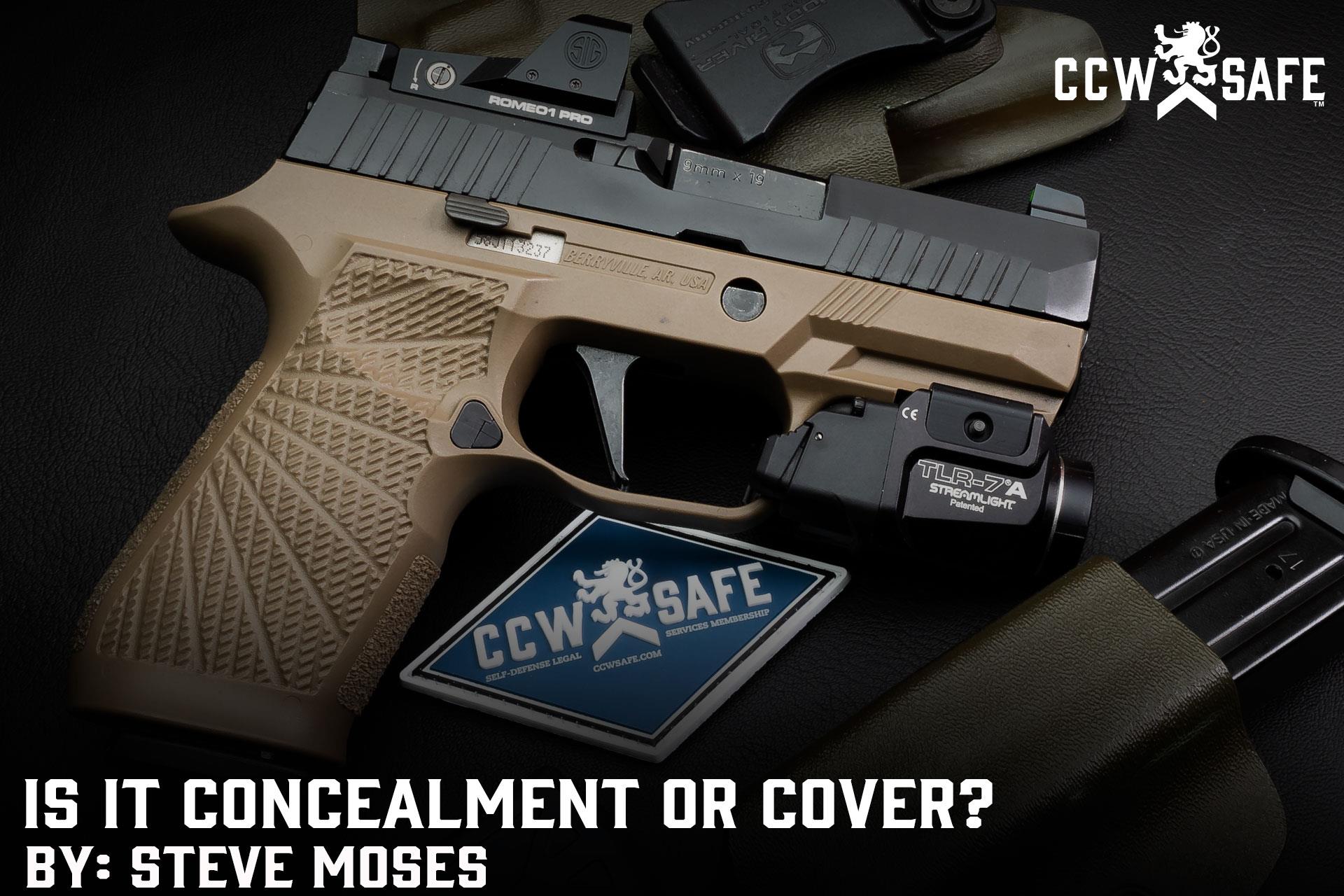
Posted on January 17, 2022
IS IT CONCEALMENT OR COVER?
Many concealed carriers have been advised at some point to always seek cover if they might become caught up in a gunfight. While this is excellent advice, reality suggests that during the most common types of street crime seeking cover is not possible, and there is actually not that much cover to be found inside of most modern-day homes and apartments.
What is “Cover?” Simply anything that can protect us from being struck by a projectile fired from a firearm, whether by stoppage or deflection. The effectiveness of cover is largely dependent on the type of firearm being employed against us as well as the weight, velocity, and even construction of the incoming projectile. Some materials that will stop an ordinary handgun round will not stop a high-velocity rifle round or a slug or buckshot round fired from a shotgun.
I think that cover may be easier to find when outdoors than it is inside of homes, apartments, and many businesses. That is where we can find large trees, concrete and brick pillars, corners of brick buildings, parking lot lampposts, and vehicle engines and axles. Most modern-day interior walls consist of drywall or sheetrock sandwiched between wood or metal frames. It is not that hard to pierce a sheetrock interior wall with a screwdriver, much less a handgun bullet. I did not really get a full understanding of how little cover there is in most houses, apartments, and mobile homes (especially mobile homes) until I became a member of a Special Response Team and participated in some high-risk forced entries.
What that means to me as a homeowner is that I need to take stock of what items in my house might actually be useful as cover if I had to exchange shots with one or more armed intruders, plus figure out how I might be able to get behind it and use it effectively. It is actually more difficult to accomplish than it looks. It is my opinion that one of the best ways to employ cover in a home is to strategically place a bookcase full of books on the wall located on the same side as the doorway leaving me enough room that I could get behind it. I would think that persons who are really concerned about ballistic protection inside their homes could “up-armor” select walls and furniture with steel plates and ballistic blankets, but I would recommend consulting with industry experts before going that route. It is vitally important to not select cover or locate it in such a way that impedes our ability to move and, if necessary, shoot an attacker who is attempting to shoot us.
Many concealed carriers do not know how to use cover properly. I like to participate in International Defensive Pistol Association (“IDPA”) action pistol matches because I am able to practice shooting, moving, and reloading skills and hang out with some great people. One slight issue that I have with IDPA is that there is tendency for some match directors to design multiple stages using moveable walls that are referred to as “cover.” First of all, it is almost impossible to find that many impenetrable walls within a house, apartment, or business that will stop incoming bullets, and the focus on speed and incorporation of fault lines rewards participants for getting close to the walls while shooting. Shooters that are too close to walls frequently allow their hands and firearm to protrude past the edge of cover. If we are clearing a room from the outside this can give away our presence, and if someone shoots at us and the incoming bullet impacts on an impenetrable barrier close to our hand, we can be hit by bullet jacket fragments. Getting too close to cover can also reduce our peripheral vision and allow an attacker to approach us from the side unseen.
A sad incident could be seen in a not-so recent video in which a police officer was flanked and shot to death by an unseen active shooter while the officer was crowding cover. As always, there are exceptions to the rules and one of those exceptions would if the concealed carrier is in danger of being engaged by a sniper shooting from an elevated position. Does that mean competition in IDPA is bad? Not as long as concealed carriers understand that in the real world most interior walls in houses will not stop bullets and getting too close to cover (or concealment for that matter) in a gunfight is probably not a good idea.
What is ‘Concealment?” It is nothing more than a vison barrier that hides our presence or current position. While it may sound like an object that is always inferior to cover, it can certainly be used to our advantage to improve our current situation and also enable us to escape or get to cover. Examples of concealment include sheetrock walls, trunks of car and beds of pickup trucks, shrubbery, shelves of potato chips, soft drinks, etc. in convenience stores, household furniture, smoke, and even darkness. What many concealed carriers may not know is that by using distance, angle, and conforming their bodies to concealment they can remain largely out of sight of a potential threat and even achieve a significant tactical advantage. That advantage is the ability to see or at least identify the presence and location of another person who may be both hostile and dangerous without them seeing us. This allows us to either remain in place sound and sight unheard, withdraw to a safer location, or move just far enough outwards to get a muzzle (if necessary) on them before they can do the same to us. Craig Douglas teaches these and other principles of armed movement in structures and I can absolutely attest that they work when properly executed.
In summary, we should keep in mind the definitions of concealment and cover and know the strengths and weaknesses of each. A savvy concealed carrier will know the difference between the two and how to use each to his or her advantage. It might be a good idea to take stock of what might constitute cover or concealment anytime we are around persons sending pre-assault cues or when we get that “gut feeling” that something out of the norm could take place. No less important is knowing that in some instances running for cover first may be better than standing in place and exchanging shots with an armed attacker.
 |
Steve MosesSteve Moses has been a defensive firearms trainer for over 26 years and is a licensed Texas Personal Protection Officer with 7 years of experience performing as shift lead on a church security detail for a D/FW area metro-church. Steve is a co-owner and Director of Training for Palisade Training Group, LLC based in Dallas, Texas. Moses is a retired deputy constable and spent over 10 years on a multi-precinct Special Response Team. He owns multiple instructor certifications, including Rangemaster Advanced Handgun Instructor and Defensive Shotgun Instructor, Red Zone Knife Defense Instructor and Adaptive Striking Foundations Instructor, Modern Samurai Project Red Dot Sight Instructor, and State of Texas Personal Protection Officer Instructor. Steve holds a BJJ Brown Belt in Relson Gracie Jiu Jitsu. He is a content contributor for CCW Safe and writes weekly articles on various subjects of interest to concealed carriers. Moses shoots competitively and holds an IDPA Expert rating. Steve is an annual presenter at the Rangemaster Tactical Conference. |